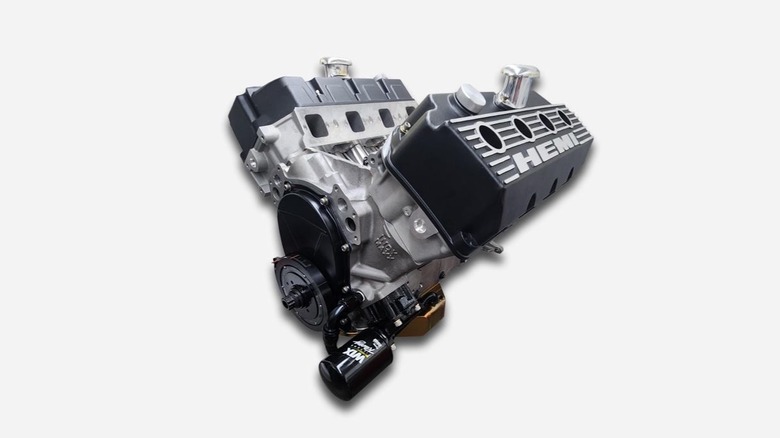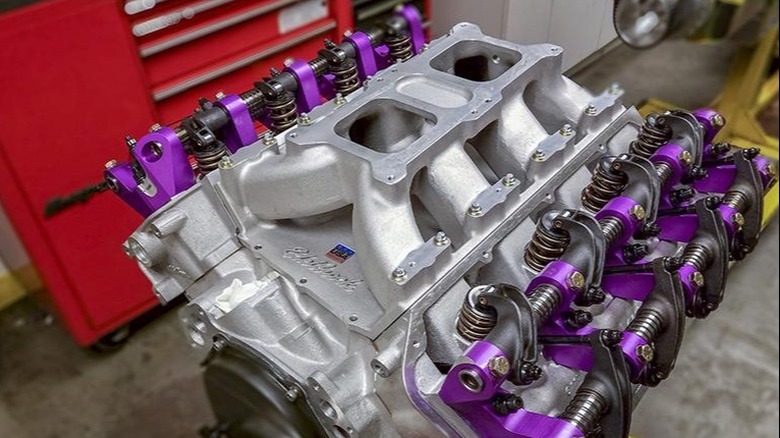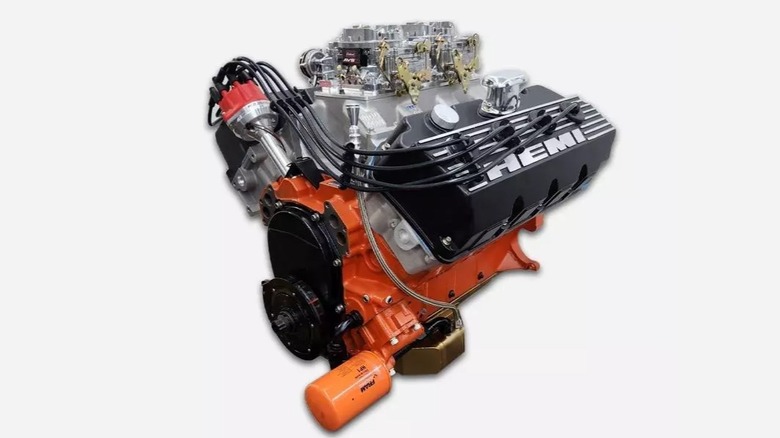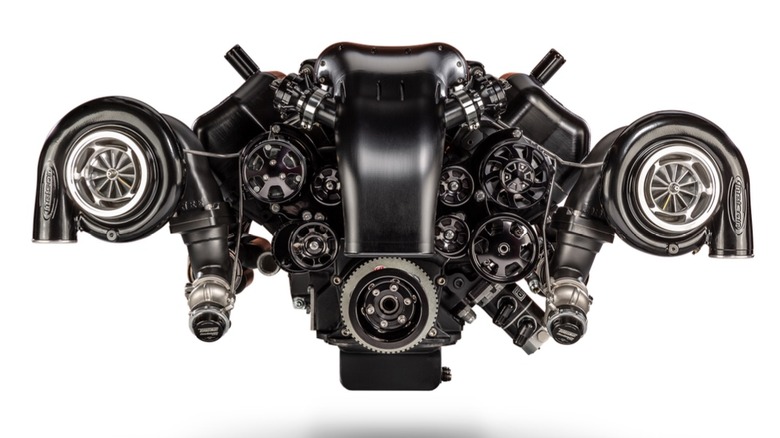Who Makes A 572 Mopar Hemi Crate Engine And How Much Horsepower Does It Produce?
If you ask any true baby boomer muscle car enthusiast about their pick for the best engine of all time, you'll likely only get a few answers. Some true old-school hot-rodders might mention the Ford Flathead V8 or the Oldsmobile Rocket 88. The more "contemporary" crowd might vote for the Chevy 427 or Ford 429 Super Cobra Jet. However, there is one engine that is respected in every muscle circle, regardless of brand affiliation, and it's the Chrysler 426 Hemi.
The 426 Hemi can be found on almost every list of best American V8 engines for a few reasons, but the main one is its legacy. The reason that the 426 Hemi even exists in the first place is Mopar's insistence to carry on their stranglehold in both NHRA and NASCAR racing series in the mid-60s. After succeeding at that mission, the 426's performance carried into the street version of the engine, which was released in 1966 with a reported 425 hp and 490 lb-ft of torque (although later dyno testing proved that it produced closer to 500 horsepower).
While the 426 Hemi's performance was unquestionably mountain-moving in factory form, tuning companies and aftermarket tinkerers have had nearly 60 years to maximize its potential. Most do that by adding more displacement, leaving those 426 cubic inches in the dust. Thanks to companies like Indy Cylinder Head and Prestige Motorsports, 572 cubic inches is the largest displacement that you can mill out of a 426 while retaining the stock camshaft position, making it a popular crate engine option for Mopar enthusiasts who have a penchant for the extreme.
Why are 572 Mopar Hemi crate engines so expensive?
The process of building a 572 Mopar Hemi crate engine is complicated. The term 'building' certainly applies here, as there are barely any original parts to work with in the 426 Hemi market. Looking at production numbers alone, only 10,904 Gen II 426 street Hemis left Mopar's Hamtramck, Michigan, plant between 1966 and 1971. Their extreme rarity means that finding one is nearly impossible and desecrating an original would be considered sacrilege. So, aftermarket manufacturers have to build the parts from scratch, then those parts have to be assembled into a complete package.
There are a number of manufacturers building Gen II Hemi parts, but most of them specialize in one aspect or require you to source parts individually. For example, companies like Keith Black Racing Engines provide custom, made-to-order 426 Hemi blocks, but other parts need to be sourced from elsewhere. In fact, blocks are one of the easiest components to source now that Callies Performance Products has arranged a licensing deal with Fiat Chrysler Automobiles to manufacture authentic 426 blocks based on original Mopar molds. That doesn't make them any less expensive, with the blocks alone selling for as much as $8,000.
The same goes for cylinder heads, with the most popular Edelbrock Victor Jr Gen II 572 Hemi heads starting at around $3,300 — when they're in stock, of course. After all of that, you still have to source the remaining rotating assembly, valve train, ignition, and induction components (among others), leading to thousands more dollars spent.
Multiple manufacturers make 572 Mopar Hemi crate engines in various forms
If sourcing your own parts isn't your cup of tea, another option is purchasing a pre-assembled 572 Mopar Hemi crate engine. Despite being a pretty specific niche within the engine-building community, several companies specialize in building max-displacement Mopar Hemis.
For the true Mopar purists, Indy Cylinder Head is the go-to manufacturer for everything 572 Hemi. Indy markets itself as the only aftermarket Mopar manufacturer, meaning that it doesn't just distribute engines, but rather manufactures them from the ground up with its own molds. While Indy makes and sells all of the parts to build your own 572 Hemi, the company also offers a pre-assembled long block with an option of either an iron Callies or an aluminum Indy block. Indy's package goes for a wallet-draining $32,100.
Prestige Motorsports is another popular name in the Hemi crate engine arena, selling turn-key 572 Mopar Hemi long blocks in a variety of options. It offers both aluminum block and iron block variants of their 572, which are both fitted with Edelbrock or Indy heads and forged rotating components. Both long blocks are rated for the same power and torque figures, but the aluminum block is the way to go if weight is a chief concern. That does come at a slight premium, with Prestige offering the aluminum block at $27,999 compared to the iron long block at $26,499.
Last but not least is a company known as For Hemis Only — or FHO for short— which specializes in, you guessed it, building custom Hemis. The manufacturer has been doing it for 30 years so rest assured, they know a thing or two about building a quality 572, which is advertised as the top seller. FHO's offering features either an Indy or Keith Black aluminum block and its own proprietary heads.
How much power can you squeeze out of a 572 Hemi?
Back in the 1960s, the original 426 Hemi made around 75 more horsepower than it was advertised to produce. With the 426's power figure hovering around 500 ponies, it's safe to say that even at that power level, Mopar built in a fair amount of breathing room as to what the engine could withstand. Since it was built for competition, the factory engine was made using extremely durable components, capable of withstanding extreme amounts of stress. Some experienced 426 engine builders claim that built 426s can withstand between 700 and 1,500 horsepower depending on how much money is thrown at the engine.
It is a pretty similar story with 572 Hemi crate engines, which are essentially just 426 Hemis with an increased bore and stroke. In many cases, cylinder wall thickness is a concern when it comes to engines with a large overbore, as thinner cylinder walls aren't as structurally rigid as thicker walls. However, most companies that build 572 crate engines sleeve the cylinders to provide some added thickness. Most companies rate their base 572 Hemi crate engines to withstand somewhere in the ballpark of 700-750 hp.
However, some builders create 572 Hemi's explicitly for boost, using stronger forged components, a lower compression ratio, and a more capable valvetrain. In addition to their standard 572 long block, Prestige Motorsport also offers a "boost ready variant" that is specially constructed to handle a massive blower and is capable of handling over 1,000 horsepower. Most 572 crate engines are heavily customizable and made to order, so they can generally be built to withstand as much horsepower as your right foot desires.



